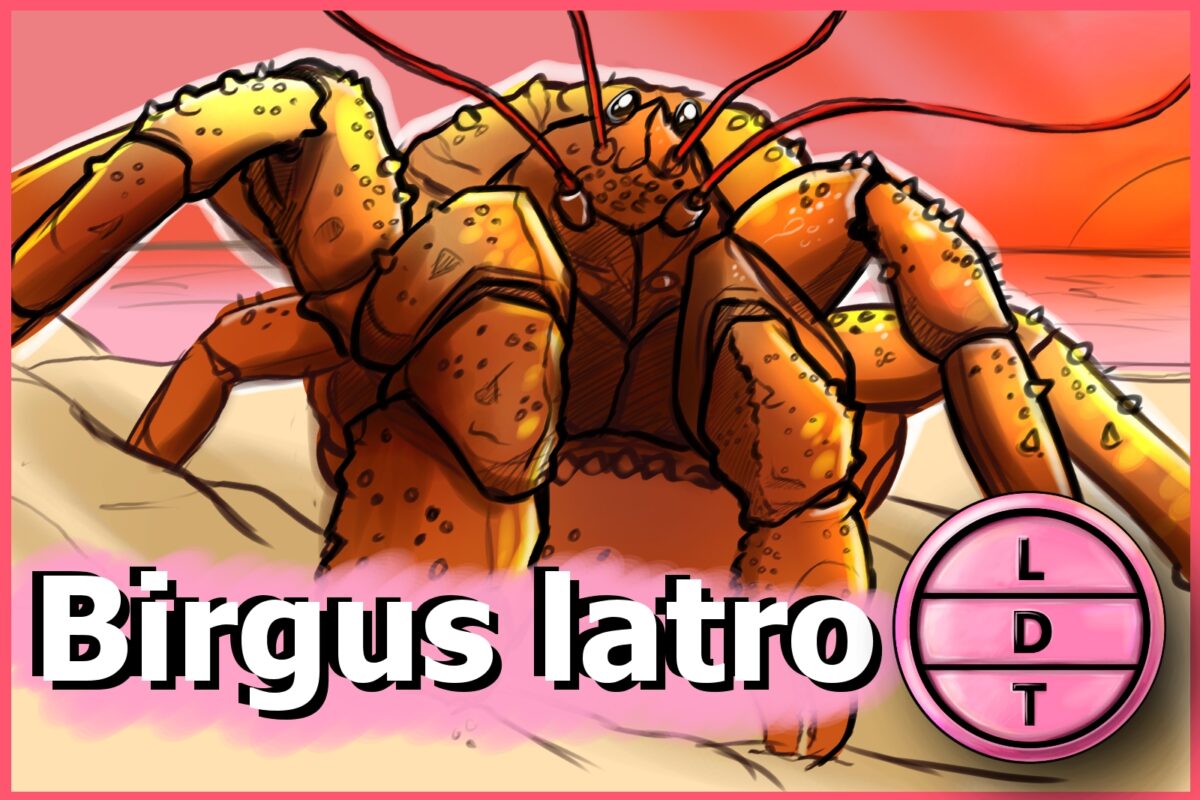“…and today we’re talking about an animal that sounds like a delicious Caribbean dish but looks like it inspired the Witcher’s endrega monsters. But more on that later.”
Scattered across the islands of the south Pacific is a population of crabs that are great in a pinch. The coconut crab is the largest land crab in the world and uses its claws to tear open more than just coconuts. From their predatory tactics to their ability to drop from the trees, this is one decapod that you don’t want to mess with on your trip to Christmas Island. But being a Pinchy Pete is just how this Krusty Krab survives here in Life, Death, and Taxonomy.
Description
- Coconut crabs are big land crustaceans that share a lot of similarities with insects.
- Unlike bulbous bodied sea crabs, coconut crabs have long thick legs that support a proportionately smaller body.
- But like crabs, they have pinchers. In fact, they’re some of the largest pinchers in the animal kingdom.
- The left pincher is always larger than the right.
- They come in a variety of colors. Typically they sport a brown, tan, or dark grey main color with bright accents. They may have red, orange, and blue coloration.
Measure Up
Welcome to the beloved Measure Up segment. The official listener’s favorite part of the show! The part of the show when we present the animal’s size and dimension in relatable terms through a quiz that’s fun for the whole family. It’s also the part of the show that’s introduced by you when you send in audio of yourself saying, singing, or chittering the words Measure Up into ldtaxonomy at gmail dot com. We don’t have a new measure up intro this week.
- Ghost Crab
- Spider Crab
- Velvet Crab
- Dungeness Crab (0:50)
Body Length
- Considering their 3 foot leg span, they appear very large, but their body length is around 40 cm (16 in).
- How many coconut crabs go into the greatest length of Christmas Island?
- Hint: Christmas island is a territory of Australia, though it’s just off the coast of Indonesia. According to the Christmas song about Christmas Island, if you spend Christmas there, your Christmas dreams will come true.
- 47,520 crabs. The island is 19 kilometres (12 mi) long.
Weight
- 4.1 kg (9.0 lb)
- How many of the world’s smallest baby ever to survive birth go into the weight of the Coconut Crab?
- Hint: The baby named Saybie was born in December 2018 after her mom had to have an emergency C-section at 23 weeks, which is 17 weeks early. Only half of babies born at this stage survive. After 5 months in the NICU, she was able to go home happy and healthy.
- 16.7 baby Saybies. Saybie was 8.6 ounces at birth.
Fast Facts About the Coconut Crab
Range: They live on the tropical islands of the Indian and Pacific oceans. They are terrestrial crabs and spend most of their time in the coastal areas of their home islands.
Diet: These crabs eat a variety of plants and animals including fruit, nuts, seeds, carcasses, turtles, other crabs species, and even members of their own species. There are even reports of them eating cats and birds. They aren’t thought to eat coconuts as a major part of their diets. Still, they are often seen grabbing and tearing into coconuts so who knows.
They’re associated with coconut producing palm trees though they don’t live in them. Instead, they burrow underground. If they stray too far from their burrows, they may escape predators by climbing up a tree, especially when they’re young.
Speaking of young, though they are land crabs, crab hatchlings are planktonic, which means they are tiny free floating organisms. So like a girl who loves the sea, it calls mother crabs to skitter down to the water’s edge to lay their eggs. As they age, they sink to the bottom of the seafloor to use shells as armor like hermit crabs. Within a year, they leave the sea and forget how to breath underwater.
Though you may have dreams of a giant crab rangoon when looking at these crustacean titans, they are poisonous to humans. The fruit they eat have toxins that build up in the crabs, which makes them toxic to consume.
Coconut crabs are long lived and may continue to grow until they reach 120 years. Each year, they molt their shells and retreat to burrows during their vulnerable naked phase. Instead of birthday cake, they eat their old shells each year.
Major Fact: Quick Claw
Strongest grip in the animal kingdom at a potential of 3000N of force – 10 times stronger than a human’s. Their arms are also strong enough to lift over 50 lb, the weight of a small child. They use their claws to tear apart their food, which is mostly fruit.
The crabs will climb over 30-ft up trees to cut down coconuts or drop coconuts that they picked up from the ground to break the husk. But rather than climb down, they’ll often just drop up to 15 feet without getting hurt.
Then they either try and rip the husk apart or whack it with their claws until it cracks so they can get at the tasty flesh. There’s a gruesome video of a crab climbing a tree to kill and eat a sleeping red-footed booby. Legend has it that coconut crabs ate Amelia Earhart’s body.
They’ll use their claws to break bones and even steal human food, which is why they’re called the robber crab or palm thief.
Lastly, they’re pretty aggressive with each other. Since they don’t have a shell as adults, they have to defend themselves with their claws. Larger palm crabs will actually kill and eat other smaller ones.
Ending: So shed your shell, get a grip on life and don’t let go like the coconut crab here in LDT

